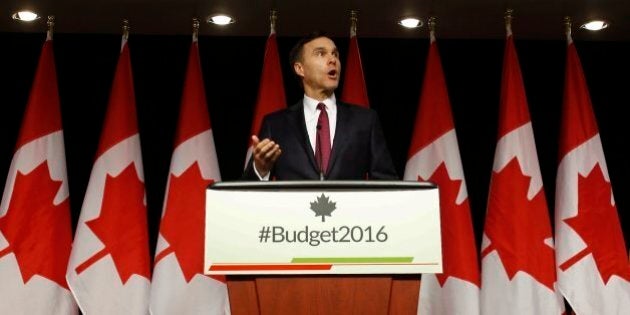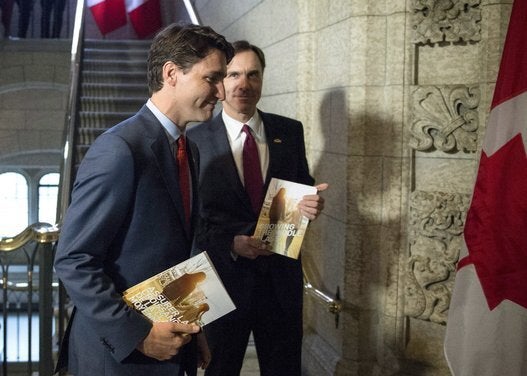
With historically low economic growth projections in the backdrop, Bill Morneau's first budget as finance minister opted for big spending over restraint, compromising the return to a balanced budget within the first mandate of the new government.
The accumulation of deficits will add over $100 billion to Canada's gross debt over the new government's mandate. Despite budget projections showing the debt-to-GDP ratio stabilizing over the long term, this relative stability is contingent on indefinitely low interest rates and economic stability.
As widely expected, the budget implements a series of campaign commitments, including reforming the child tax benefit system, increasing federal cash transfers to seniors and veterans, increasing outlays for culture and First Nations, and spending billions of dollars on provincial and municipal infrastructure in hope to boost consumption and stimulate the economy.
On the side of good news, new spending on infrastructure can provide a timely (but small) boost to the economy. The challenge will be to bring forward those large new capital investments in a timely manner. The level of coordination required with provinces and municipalities can slow things down.
The child benefit reform will be good news for low- to-mid income families with children, who will see their total payments increase. Money saved from the elimination of the Family Tax Cut and Universal Child Care Benefit will be reinvested in the new system, letting low- and modest-income families keep more of their benefits as their income rises, positively impacting their work decisions and the economy.
We've seen this story before in the mid-1990s, when out-of-control deficits and an impending sovereign debt crisis led to painful spending cuts and tax increases.
The decision to rescind the previously planned increase of the normal retirement age -- bringing it back to 65 years old from the planned 67 -- was made to protect a minority of retired low-income seniors from poverty while they would have had to wait an additional two years before being eligible for Old Age Security. The decision, however, fails to recognize longer life expectancy and the current trend towards later retirements. By 2030, about 40 per cent of 65- to 69-year-old seniors will likely be both working and collecting an OAS pension.
The normal age of retirement plays an important symbolic role: it sends a signal to workers planning for their retirement. What is considered normal is naturally subjective, but the eligibility age for OAS contributes to entrench our cultural belief over normal retirement length, influencing retirement planning.
The beneficial economic and fiscal impacts of working longer are clear. By reducing the stress of demography on the labour market and on the pension system, a higher retirement age could play a major role in our future ability to bear the fiscal and social cost of an aging population.
Overall, government spending on programs and operations will be $12.5 billion and $16.5 billion higher than previously projected in each of the next two years. Much of this annual new spending carries over to future years, increasing the size of government and resulting in large recurring deficits over the entire length of the five-year planning horizon.
In effect, the Liberals traded their commitment to achieving budgetary balance within their mandate for targeting a stable or decreasing debt-to-GDP ratio. But debt-to-GDP ratios make a lousy fiscal anchor. Many unforeseen factors could make the ratio rise rapidly.
Only tight fiscal discipline can balance the budget within a reasonable timeframe, protecting Canadians' standards of living from future large tax increases and cuts to government services.
Hopefully the next recession is not around the corner, but predicting business cycles is an impossible task. The next economic contraction is sure to make a large dent in the debt-to-GDP ratio.
Making things worse, when the economy expands rapidly, how do you maintain tight budgetary discipline when deficits become the norm? And once on the books, we all know how difficult it is to cut government programs.
Interest rates are now at historical lows. Their decline resulted in huge budgetary savings over the years. In 2007/08, the federal interest-bearing debt stood at $582 billion with debt charges of $33 billion. Twelve years later, by the end of the current government's mandate, debt charges will still be $33 billion, despite a more than $400 billion gross debt increase.
If interest rates rise substantially, debt charges would escalate rapidly, making the debt situation worse. We've seen this story before in the mid-1990s, when out-of-control deficits and an impending sovereign debt crisis led to painful spending cuts and tax increases.
The government is wrong to make the return to budget balance conditional on strong economic growth. Population aging is already taking its toll on long-term projections, and too many unforeseen events can derail the fiscal path.
Only tight fiscal discipline can balance the budget within a reasonable timeframe, protecting Canadians' standards of living from future large tax increases and cuts to government services.
Follow HuffPost Canada Blogs on Facebook
MORE ON HUFFPOST:
